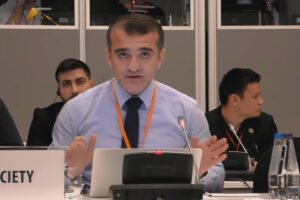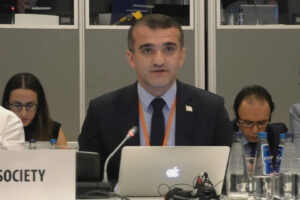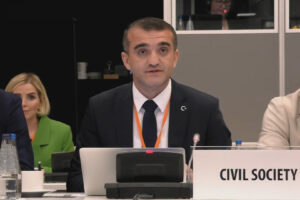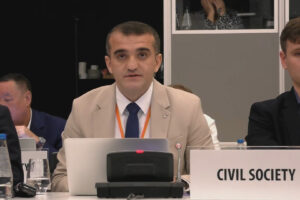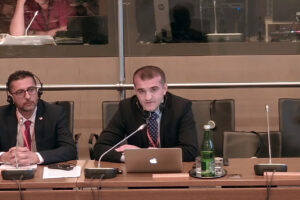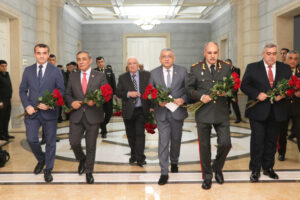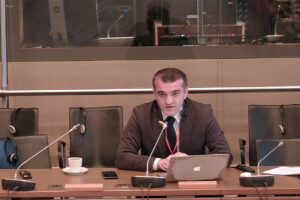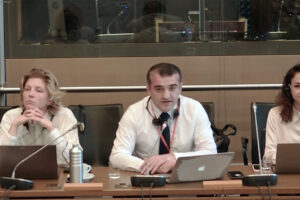Respect the ceasefire; double the peace efforts, MG Co-chair urges Baku, Yerevan

TURAN’s interview with Ambassador James Warlick, top US envoy on the conflict
As shots across the Line of Contact between Azerbaijan and Armenia have recently become more common, causing reportedly at least 50 lives from both sides in the past few weeks, many that were involved in the peacemaking efforts, worry thata settlement will not be possibleamid growing tension and mistrustbetween the Armenian and Azerbaijani people.
The Minsk Group, the OSCE body that works on resolving the conflict, has long been urging the sides to refrain from the use of threat or force in the conflict zone.
In Washington, DC, officials hope for the “re-doubled efforts and confidence” on the peace negotiations, top US envoy on the conflict, stated on Friday, August 29, in an interview with Turan’s Washington, DC correspondent.
In his interview Ambassador James Warlick, a US co-chair of the Minsk Group, commented on the recent situation around the conflict, invited the governments in Baku and Yerevan to step up their commitment to the peace process, as well as addressed both Azerbaijani, Armenian audiences to understand the advantages of the negotiations.
Q. It seems like there is a number of questions both in Azerbaijani and Armenian societies regarding the Minsk Group’s role in the negotiation process, as many blame the co-chairs in being inactive… Albeit as a top US negotiator, you’re probably one of a few dynamic diplomats directly involved in the process, who frequently visits the region, talks to the media, even sometimes appears at a think-tank to outline US policy statement in a public speech… How would you describe the MG daily activity and where is it right now, what is being done and, in your opinion, should be done moving ahead through the process?
A.First, thank you for coming in to the State Department. It is good to have the opportunity to talk to you. I know your audience is a very large one, and I’m glad I’ll be able to talk to them through you. Thank you for your comments on my role as the co-chair of the Minsk Group.
We are trying to provide more transparency, and I think that is very important for the people of both Armenia and Azerbaijan to understand, not just to read a few headlines and hear about a meeting that is taking place, but also to understand the issues at stake.
One of the outcomes of my speech at the Carnegie a few months ago was that it did stimulate discussion, and a helpful discussion. It helped people to focus on what are the key issues, where do we stand on these, and how can we find a way to a peaceful settlement. But we all know that this is not easy, otherwise we wouldn’t be 20 years later after the ceasefire still negotiating, still mediating and talking about this. It is difficult to find a way forward that is acceptable to all involved. And so sometimes it can be easy to criticize the Minsk Group, but that is completely understandable. We wantto work with the sides on making progress, but it’s difficult for us, and sometimes frustrating that we don’t see the progress that we would like.
I think it is important for us to continue to work, not to step back and simply throw up our hands and say that this is hopeless. It is not hopeless. In fact the sides are close, they have come close in the past; they are close now. So, I think it is important for us to work with the sides in finding a way forward to peaceful settlement.
Q: Twenty years ago the withdrawal of troops, return of refugees, and other necessary steps looked like logical next steps after the ceasefire agreement. None of this occurred. Instead, given the recent wave of ceasefire violations in the Line of Contact, there is a growing concern in the region regarding how fragile this ceasefire is… Some local analysts urge the governments to renew or strengthen the 1994 agreement to prevent death of dozens of young men. Is this something that the MG currently is discussing with the sides?
A. We want to see the ceasefire respected. The recent wave of violence, which began on July 31, was of great concern to us. That kind of violence is a setback at our ability to reach a peaceful settlement, and it does represent violation of the ceasefire. It’s in no one’s interest to escalate the conflict; there is no military solution to this. We need to work and re-double our efforts at the negotiating table to find solution. A starting point for that is respecting the ceasefire. We have seen in the recent weeks a reduction of tensions, and we hope that it will continue.
Q. There are also some calls regarding establishing an “incident investigation mechanism…”Is the MG considering any kind of mechanism to tackle this problem?
A. The first responsibility falls to the parties. When there are deaths and injuries — and there have been a couple of notable cases recently, — there should be full investigation. If there are injuries or deaths of civilians, if such deaths or injuries happen in custody, there should be an investigation on this. I would call on both sides to take the steps necessary to fully investigate these instances. This is not just a matter of the right thing to do, but is a question of international humanitarian law.
So, you are right to point this out. There has also been a discussion within OSCE about an investigative mechanism. We support that, the co-chairs supported it, but, of course, it’s up to the parties. They need to agree on that, and we would welcome a renewed discussion between Armenia and Azerbaijan on conditions for putting in place such an investigative mechanism.
Q. As for the practical aspects of the conflict settlement, in your statement in early May at Carnegie Institution, you mentioned that Armenia and Azerbaijan agree on the basic elements of a Nagorno-Karabakh settlement and must now take final “bold steps” to hammer out a historic peace deal.So, it sounded likesides were much closerto the decision moment back then. Did we understand it correctly, or are there still a lot of differences between both sides?
A. Noone in Armenia or Azerbaijan understands this conflict better than the two presidents. They have lived through this issue, and they are the ones that will need to decide on the way forward. They know exactly what it will take to find a settlement. And that’s what we are trying to do — we are trying to bring the presidents together… Now they met on a personal visit with president Putin in Sochi on August 10. I don’t know all the details of their discussions, but I understand that it was a substantive discussion, and I hope that they were able to at least help define the issues and look for a way forward. They have already committed to meeting again in Paris at the end of October at the invitation of president Hollande. We look forward to that meeting.
There is also an opportunity for the presidents to come together, and we are not sure whether this is possible or not, either at the NATO summit, if both presidents attend, and that will be next week in Wales; and also on the margins of the UN General Assembly. We look at all of these opportunities for the presidents to come together as helpful in the process of moving forward towards the settlement.
We, the US, the co-chairs are all prepared to play our role, and Secretary Kerry as well, is prepared to be personally involved if his involvement is helpful and bringing about the settlement. At this point we will continue along this track.
The Swiss and their capacity as chairman-in-office of the OSCE, has also made an offer to the sides to enter into the negotiations. We believe that this is a helpful offer, and we have encouraged the sides to take this seriously, ad to accept the offer.
The fact is that it is not enough for the presidents or the foreign ministers to meet on an occasional basis. We need a sustained process that lead to the conclusion of a peace agreement. And the way that we need to do that is through negotiation. So my message is “let’s get started”.
Q. Speaking about the Sochi discussions, many observers were surprised by not seeing you and your MG colleagues at the latest meeting between presidents Aliyev and Sargsyan. Just to clarify, was the meeting a Russia-backed initiative that sidelined MG from the process or was it a join initiative but due to technical or other reasons you couldn’t make it there?
A. Well, that’s a good question to ask to the Russians, but my understanding is that this was a personal invitation by president Putin to Sochi to his dacha. These weren’t official visits, and I would only say that we have worked very closely together with the Russians on NagornoKarabakh, despite our differences in other parts of the world. And the fact is that the Russian co-chair and I are often in touch. We see eye to eye on this, and we would like to find a way forward towards a settlement, and we look forward to a continued cooperation with Russia, and a positive role from Moscow.
Q. Yet it’s difficult for many in the region to imagine how Russia can appear on the same stage with the West, trying to position itself a peacemaker on Nagorno-Karabakh, while it’s seen as a troublemaker in other part of the region – in Ukraine?
A. The fact is that there are issues around the world where we will need to continue to work with the Russians. We hope that we can continue being productive on those issues where we see eye to eye, and where our cooperation is needed.
The fact is that we have all the recent years and we continue to work closely on NagornoKarabakh. We remain committed to the co-chair format, as do Azerbaijan and Armenia.
Q. As the Minsk Group has long been urging the sides for people-to-people diplomacy,or as it’s often called “track-two” in diplomatic language, is there any sufficient plan regarding a much greater involvement of society?
A. I think it’s so important to have people-to-people programs. If we are able to reach peaceful settlement, there will need to be a basis of confidence and trust between the sides, and this doesn’t just mean between the governments, it means between the peoples of the both countries.
There should be, it is a very long process of encouraging the people-to-people contact. Now the co-chairs, the US as well, we all put forward proposals, that we believe, are not controversial. Technical visits, sports diplomacy, youth exchange, an emphasis on education or health, these are the areas where we can begin to see some cooperation. What we want to see is both governments agree on these kinds of programs. So, this is a challenge.
When I took this job nearly a year ago, I thought, how difficult can this be? Everyone supports education, health and youth exchange; right? Well, the fact is that it is difficult to get the sides to agree. There are some NGOs that are doing some good work, and we value their work, but it’s also important for the governments to laying this foundation of trust and confidence. This will be necessary for any settlement.
Q. In fact, years ago, there was a jointtrip by intellectuals and former diplomatsto Yerean, Baku and even to Xankendi. In the meantime, we see that the government in Azerbaijan doesn’t support any “unmanaged” actions of that kind… Is the MG planning to come up with alternative plan by involving the average people and coordinating it with the governments?
A. There have been successful and less successful people-to-people programs. Sometimes they have been abused for political purposes. We need to work on this and understand that this is a long-term process, and we need to start building it.
You know, 30 years ago there was frequent contact between Azerbaijanis and Armenians, but today there is a whole generation that no understanding of each other, that haven’t met each other. Gone are the days when Azerbaijanis and Armenians lived side-by-side.
We need to work on this issue specially so the young people in both countries understand the value of peace, and that there can be the trust and confidence to have a sustained and lasting peace.
AlakbarRaufoglu,
Washington, DC
08/29/2014
Respect the ceasefire; double the peace efforts, MG Co-chair urges Baku, Yerevan
 30 August 2014
30 August 2014
TURAN’s interview with Ambassador James Warlick, top US envoy on the conflict
As shots across the Line of Contact between Azerbaijan and Armenia have recently become more common, causing reportedly at least 50 lives from both sides in the past few weeks, many that were involved in the peacemaking efforts, worry thata settlement will not be possibleamid growing tension and mistrustbetween the Armenian and Azerbaijani people.
The Minsk Group, the OSCE body that works on resolving the conflict, has long been urging the sides to refrain from the use of threat or force in the conflict zone.
In Washington, DC, officials hope for the “re-doubled efforts and confidence” on the peace negotiations, top US envoy on the conflict, stated on Friday, August 29, in an interview with Turan’s Washington, DC correspondent.
In his interview Ambassador James Warlick, a US co-chair of the Minsk Group, commented on the recent situation around the conflict, invited the governments in Baku and Yerevan to step up their commitment to the peace process, as well as addressed both Azerbaijani, Armenian audiences to understand the advantages of the negotiations.
Q. It seems like there is a number of questions both in Azerbaijani and Armenian societies regarding the Minsk Group’s role in the negotiation process, as many blame the co-chairs in being inactive… Albeit as a top US negotiator, you’re probably one of a few dynamic diplomats directly involved in the process, who frequently visits the region, talks to the media, even sometimes appears at a think-tank to outline US policy statement in a public speech… How would you describe the MG daily activity and where is it right now, what is being done and, in your opinion, should be done moving ahead through the process?
A.First, thank you for coming in to the State Department. It is good to have the opportunity to talk to you. I know your audience is a very large one, and I’m glad I’ll be able to talk to them through you. Thank you for your comments on my role as the co-chair of the Minsk Group.
We are trying to provide more transparency, and I think that is very important for the people of both Armenia and Azerbaijan to understand, not just to read a few headlines and hear about a meeting that is taking place, but also to understand the issues at stake.
One of the outcomes of my speech at the Carnegie a few months ago was that it did stimulate discussion, and a helpful discussion. It helped people to focus on what are the key issues, where do we stand on these, and how can we find a way to a peaceful settlement. But we all know that this is not easy, otherwise we wouldn’t be 20 years later after the ceasefire still negotiating, still mediating and talking about this. It is difficult to find a way forward that is acceptable to all involved. And so sometimes it can be easy to criticize the Minsk Group, but that is completely understandable. We wantto work with the sides on making progress, but it’s difficult for us, and sometimes frustrating that we don’t see the progress that we would like.
I think it is important for us to continue to work, not to step back and simply throw up our hands and say that this is hopeless. It is not hopeless. In fact the sides are close, they have come close in the past; they are close now. So, I think it is important for us to work with the sides in finding a way forward to peaceful settlement.
Q: Twenty years ago the withdrawal of troops, return of refugees, and other necessary steps looked like logical next steps after the ceasefire agreement. None of this occurred. Instead, given the recent wave of ceasefire violations in the Line of Contact, there is a growing concern in the region regarding how fragile this ceasefire is… Some local analysts urge the governments to renew or strengthen the 1994 agreement to prevent death of dozens of young men. Is this something that the MG currently is discussing with the sides?
A. We want to see the ceasefire respected. The recent wave of violence, which began on July 31, was of great concern to us. That kind of violence is a setback at our ability to reach a peaceful settlement, and it does represent violation of the ceasefire. It’s in no one’s interest to escalate the conflict; there is no military solution to this. We need to work and re-double our efforts at the negotiating table to find solution. A starting point for that is respecting the ceasefire. We have seen in the recent weeks a reduction of tensions, and we hope that it will continue.
Q. There are also some calls regarding establishing an “incident investigation mechanism…”Is the MG considering any kind of mechanism to tackle this problem?
A. The first responsibility falls to the parties. When there are deaths and injuries — and there have been a couple of notable cases recently, — there should be full investigation. If there are injuries or deaths of civilians, if such deaths or injuries happen in custody, there should be an investigation on this. I would call on both sides to take the steps necessary to fully investigate these instances. This is not just a matter of the right thing to do, but is a question of international humanitarian law.
So, you are right to point this out. There has also been a discussion within OSCE about an investigative mechanism. We support that, the co-chairs supported it, but, of course, it’s up to the parties. They need to agree on that, and we would welcome a renewed discussion between Armenia and Azerbaijan on conditions for putting in place such an investigative mechanism.
Q. As for the practical aspects of the conflict settlement, in your statement in early May at Carnegie Institution, you mentioned that Armenia and Azerbaijan agree on the basic elements of a Nagorno-Karabakh settlement and must now take final “bold steps” to hammer out a historic peace deal.So, it sounded likesides were much closerto the decision moment back then. Did we understand it correctly, or are there still a lot of differences between both sides?
A. Noone in Armenia or Azerbaijan understands this conflict better than the two presidents. They have lived through this issue, and they are the ones that will need to decide on the way forward. They know exactly what it will take to find a settlement. And that’s what we are trying to do — we are trying to bring the presidents together… Now they met on a personal visit with president Putin in Sochi on August 10. I don’t know all the details of their discussions, but I understand that it was a substantive discussion, and I hope that they were able to at least help define the issues and look for a way forward. They have already committed to meeting again in Paris at the end of October at the invitation of president Hollande. We look forward to that meeting.
There is also an opportunity for the presidents to come together, and we are not sure whether this is possible or not, either at the NATO summit, if both presidents attend, and that will be next week in Wales; and also on the margins of the UN General Assembly. We look at all of these opportunities for the presidents to come together as helpful in the process of moving forward towards the settlement.
We, the US, the co-chairs are all prepared to play our role, and Secretary Kerry as well, is prepared to be personally involved if his involvement is helpful and bringing about the settlement. At this point we will continue along this track.
The Swiss and their capacity as chairman-in-office of the OSCE, has also made an offer to the sides to enter into the negotiations. We believe that this is a helpful offer, and we have encouraged the sides to take this seriously, ad to accept the offer.
The fact is that it is not enough for the presidents or the foreign ministers to meet on an occasional basis. We need a sustained process that lead to the conclusion of a peace agreement. And the way that we need to do that is through negotiation. So my message is “let’s get started”.
Q. Speaking about the Sochi discussions, many observers were surprised by not seeing you and your MG colleagues at the latest meeting between presidents Aliyev and Sargsyan. Just to clarify, was the meeting a Russia-backed initiative that sidelined MG from the process or was it a join initiative but due to technical or other reasons you couldn’t make it there?
A. Well, that’s a good question to ask to the Russians, but my understanding is that this was a personal invitation by president Putin to Sochi to his dacha. These weren’t official visits, and I would only say that we have worked very closely together with the Russians on NagornoKarabakh, despite our differences in other parts of the world. And the fact is that the Russian co-chair and I are often in touch. We see eye to eye on this, and we would like to find a way forward towards a settlement, and we look forward to a continued cooperation with Russia, and a positive role from Moscow.
Q. Yet it’s difficult for many in the region to imagine how Russia can appear on the same stage with the West, trying to position itself a peacemaker on Nagorno-Karabakh, while it’s seen as a troublemaker in other part of the region – in Ukraine?
A. The fact is that there are issues around the world where we will need to continue to work with the Russians. We hope that we can continue being productive on those issues where we see eye to eye, and where our cooperation is needed.
The fact is that we have all the recent years and we continue to work closely on NagornoKarabakh. We remain committed to the co-chair format, as do Azerbaijan and Armenia.
Q. As the Minsk Group has long been urging the sides for people-to-people diplomacy,or as it’s often called “track-two” in diplomatic language, is there any sufficient plan regarding a much greater involvement of society?
A. I think it’s so important to have people-to-people programs. If we are able to reach peaceful settlement, there will need to be a basis of confidence and trust between the sides, and this doesn’t just mean between the governments, it means between the peoples of the both countries.
There should be, it is a very long process of encouraging the people-to-people contact. Now the co-chairs, the US as well, we all put forward proposals, that we believe, are not controversial. Technical visits, sports diplomacy, youth exchange, an emphasis on education or health, these are the areas where we can begin to see some cooperation. What we want to see is both governments agree on these kinds of programs. So, this is a challenge.
When I took this job nearly a year ago, I thought, how difficult can this be? Everyone supports education, health and youth exchange; right? Well, the fact is that it is difficult to get the sides to agree. There are some NGOs that are doing some good work, and we value their work, but it’s also important for the governments to laying this foundation of trust and confidence. This will be necessary for any settlement.
Q. In fact, years ago, there was a jointtrip by intellectuals and former diplomatsto Yerean, Baku and even to Xankendi. In the meantime, we see that the government in Azerbaijan doesn’t support any “unmanaged” actions of that kind… Is the MG planning to come up with alternative plan by involving the average people and coordinating it with the governments?
A. There have been successful and less successful people-to-people programs. Sometimes they have been abused for political purposes. We need to work on this and understand that this is a long-term process, and we need to start building it.
You know, 30 years ago there was frequent contact between Azerbaijanis and Armenians, but today there is a whole generation that no understanding of each other, that haven’t met each other. Gone are the days when Azerbaijanis and Armenians lived side-by-side.
We need to work on this issue specially so the young people in both countries understand the value of peace, and that there can be the trust and confidence to have a sustained and lasting peace.
AlakbarRaufoglu,
Washington, DC
08/29/2014
 @
@










